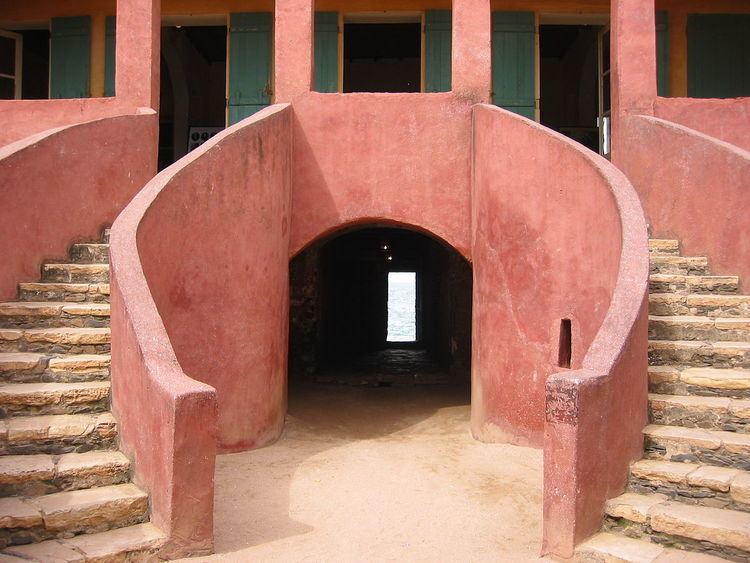Phone +221 77 635 23 49 | ||
 | ||
Hours Open today · Open 24 hoursWednesdayOpen 24 hoursThursdayOpen 24 hoursFridayOpen 24 hoursSaturdayOpen 24 hoursSundayOpen 24 hoursMondayOpen 24 hoursTuesdayOpen 24 hours Similar Gorée, IFAN Museum of African Arts, African Renaissance Monument, Mosque of the Divinity, Our Lady of Victories Cathedral | ||
The House of Slaves (Maison des Esclaves) and its Door of No Return is a museum and memorial to the Atlantic slave trade on Gorée Island, 3 km off the coast of the city of Dakar, Senegal. Its museum, which was opened in 1962 and curated until Boubacar Joseph Ndiaye's death in 2009, is said to memorialise the final exit point of the slaves from Africa. While historians differ on how many African slaves were actually held in this building, as well as the relative importance of Gorée Island as a point on the Atlantic Slave Trade, visitors from Africa, Europe, and the Americas continue to make it an important place to remember the human toll of African slavery.
Contents
Memorial
The House of Slaves was reconstructed and opened as a museum in 1962 largely through the work of Boubacar Joseph Ndiaye (1922 – 2009). Ndiaye was an advocate of both the memorial and proclamation that slaves were held in the building in great numbers and from here transported directly to the Americas. Eventually becoming curator of the Museum, Ndiaye claimed that more than a million slaves passed through the doors of the house. This belief has made the house both a tourist attraction and the site for state visits by world leaders to Senegal.
Academic controversy
Since the 1980s, academics have downplayed the role that Gorée played in the Atlantic Slave Trade while others have exalted it, arguing that it is unlikely that many slaves actually walked through the door, and that Gorée itself was marginal to the Atlantic slave trade. Ndiaye and other Senegalese have always maintained that the site is more than a memorial and is an actual historic site in the transport of Africans to British, French, Spanish, Dutch, and Portuguese colonies of the Americas, and thus undercounted by Anglophone researchers.
Built around 1776, the building was the home in the early 19th century to one of a class wealthy colonial Senegalese Métis woman trader (the Signares), Anna Colas Pépin. Researchers argue that while the houseowner may have sold small numbers of slaves (kept in the now reconstructed basement cells) and kept a few domestic slaves, the actual point of departure was 300m away at a fort on the beach. The house has been restored since the 1970s. Despite the significance of Gorée Island, some historians have made claim that only 26,000 enslaved Africans were recorded having passed through the island, of the unknown number of slaves that were exported from Africa. Ndiaye and supporters have submitted that there is evidence, the building itself, was originally built to hold a large numbers of slaves, and that as many as 15 million people passed through this particular Door of No Return.
Academic accounts, such as the 1969 statistical work of historian Philip D. Curtin, argue that enforced transports from Gorée began around 1670 and continued until about 1810, at no time more than 200 to 300 a year in important years and none at all in others. Curtin's 1969 accounting of enforced trade statistics records that between 1711 and 1810 180,000 enslaved Africans were transported from the French posts in Senegambia, most being transported from Saint-Louis, Senegal, and James Fort in modern Gambia Curtin has been quoted that the actual doorway memorialised likely had no historical significance In response to these figures, popularly rejected by much of the Senegalese public, an African historical conference in 1998 claimed that records from the French trading houses of Nantes documented 103,000 slaves being from Gorée on Nantes-owned ships in a single year in the 18th century.
Even those who argue Gorée was never important in the slave trade view the island as an important memorial to a trade that was carried on in greater scale from ports in modern Ghana and Benin.
Tourism
Despite the controversy, the Maison des Esclaves is a central part of the Gorée Island UNESCO World Heritage site, named in 1978, and a major draw for foreign tourists to Senegal. Only 20 minutes by ferry from the city centre of Dakar, 200,000 visitors a year pass through the Museum here. Many, especially those descended from enslaved Africans, describe highly emotional reactions to the place, and the pervasive influence of Ndiaye's interpretation of the historical significance of the building: especially the Door of No Return through which Ndiaye argued millions of enslaved Africans left the continent for the last time. Before his death in 2008, Ndiaye would personally lead tours through basement cells, out through the Door of No Return, and hold up to tourists iron shackles, like those used to bind enslaved Africans. Since the publication of Alex Haley's novel Roots: The Saga of an American Family in 1976, African American tourists from the United States have made the Museum a focal point, often a highly emotion laden one, of pilgrimages hoping to reconnect with their African heritage.
Notable world leaders include the Maison des Esclaves on their state visits: Pope John Paul II, Nelson Mandela, and Barack Obama have all made high-profile stops. Mandela was reported to have broken away from a tour to sit alone in a basement cell for five minutes in silent reflection upon his visit here. Obama toured "The Door of No Return" during his visit there in 2013.
